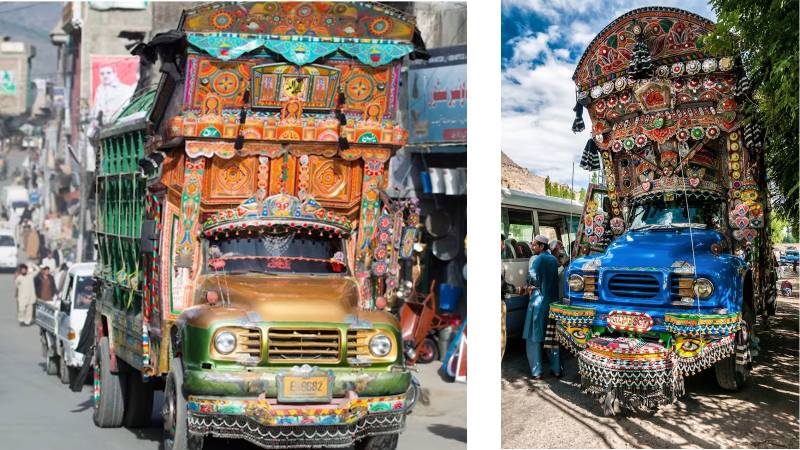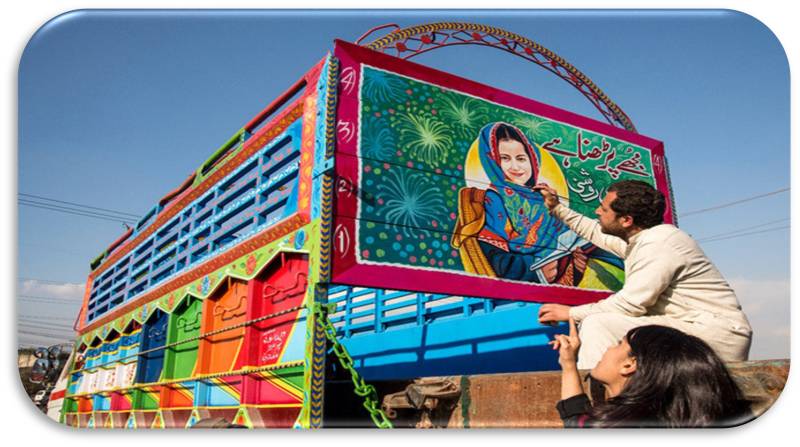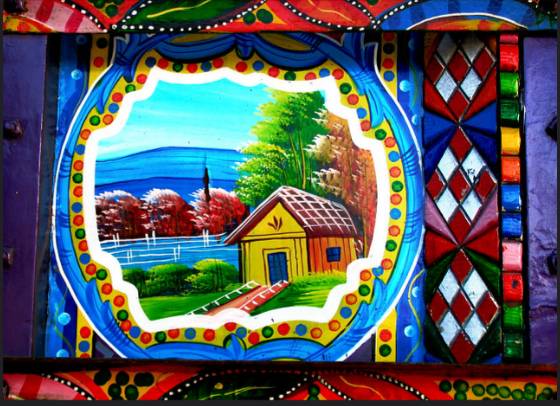
Pakistani truck art, with its colourful and intricate designs, has become a symbol of the country's rich heritage and artistic talents. This distinctive folk art style not only enhances the aesthetic appeal of the trucks but also functions as a powerful storytelling medium that showcases Pakistani culture. Truck art in Pakistan has existed for a long time. It is believed that the practice began in the 1920s when truck drivers started decorating their vehicles with a simple floral pattern. This evolution is made possible by the tradition of 'taanka,' in which artisans stitch colourful threads onto fabrics to create intricate designs. The combination of indigenous trucking culture and this technique on trucks has created a vibrant combination today.
The bold and vivid colour pattern of Pakistani truck art is what makes it unique. Each colour has significance, often representing different emotions, cultural symbols, or regional identities. The vibrant reds, blues, and yellows are both visually appealing and convey stories that are deeply rooted in the country's history and culture. The art on the trucks is not restricted to abstract patterns as it is a way to convey different stories. There is a common occurrence of scenes from epics like the portrayals of historical heroes. Trucks become mobile canvases for conveying messages and beliefs when political slogans, quotes, and poetry are applied to them.
The essence of Pakistani truck art lies in the expertise of its artisans. These skilled painters and decorators dedicate careful attention to hand-paint every inch of the trucks, showcasing an astonishing level of detail and precision. Often, these artists inherit their craft from ancestors, ensuring the continuity of techniques and trade secrets. It goes beyond mere painting; the incorporation of reflective materials and tiny mirrors introduces an additional layer to the art. As the trucks navigate the roads after sunset, they transform into captivating arrays of light, presenting a visual extravaganza that is not only enchanting but also serves a practical purpose by enhancing visibility.
Pakistani truck art rises above simple visual appeal; it stands as a profound expression of culture that resonates with people from all walks of life. This art form mirrors the rich cultural tapestry of Pakistan, drawing inspiration from diverse regions and ethnic backgrounds. In doing so, it becomes a visual embodiment of unity amid the country's cultural diversity, with trucks from different areas proudly showcasing their distinct artistic identities. Furthermore, the significance of truck art extends beyond its cultural impact. It plays a crucial role in the social and economic landscape, offering employment opportunities to numerous artisans and sustaining a thriving cottage industry rooted in creativity. Beyond borders, these mobile masterpieces serve as cultural ambassadors, capturing the attention of international audiences and showcasing the artistic prowess of Pakistan on the global stage.

Even with its widespread acclaim, Pakistani truck art encounters obstacles. The push towards modernization and the prevalence of standardized, mass-produced designs pose a risk to the traditional skills inherent in this art form. Concerns also arise regarding the environmental implications of the materials used. Yet, the strength of truck art lies in its adaptability. Solutions such as digital printing and the exploration of sustainable materials are being actively pursued to tackle these challenges, all while safeguarding the fundamental spirit of the craft. People are working to keep Pakistani truck art alive and thriving by finding a balance between tradition and sustainability in the changing times.
Over the past few years, Pakistani truck art has earned recognition on a global scale, moving beyond its original local context. Through art exhibitions, documentaries and partnerships with designers from around the world, this distinctive form of expression has found its way to an international audience. The vibrant colours and detailed designs have entranced art enthusiasts globally, igniting a growing fascination with the cultural and artistic wealth of Pakistan.
And so, Pakistani truck art has transcended its local origins and gained global recognition. International artists and enthusiasts have expressed admiration for the intricate detailing and cultural richness embedded in each design.

Fariha Ahmed, an art curator, comments on the global appeal: "Pakistani Truck Art is a visual feast. The explosion of colours and the cultural narratives make it stand out. It's fascinating to see how an art form born on the streets of Pakistan has captured the attention of the global art community."
International collaborations and partnerships have emerged, bringing Pakistani truck art to new audiences. From fashion runways featuring truck art-inspired designs to collaborations with global brands, this traditional art form has found new avenues for expression beyond the highways of Pakistan.
The intricate patterns and bold colours not only make trucks visually appealing but also reflect Pakistan's diverse history. These artists, who inherit their craft from ancestors, add a level of detail that sets this art form apart. Beyond aesthetics, truck art plays a vital role in supporting jobs and sustaining a creative industry. Its global recognition through exhibitions and collaborations showcases its universal appeal.
As Pakistani truck art navigates tradition, modernity and globalization, it is crucial to preserve its authenticity. Efforts to document the stories behind each truck and the techniques used by artisans ensure that this unique heritage is passed down to future generations.

